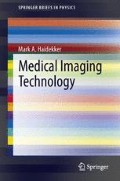Abstract
Nuclear imaging is related to X-ray and CT imaging in that it uses radiation. However, unlike X-ray based imaging modalities, radioactive compounds are injected into the body as radiation sources. These radioactive compounds are typically linked to pharmacologically active substances (“radiopharmaceuticals”) that accumulate at specific sites in the body, for example, in a tumor. With either projection techniques or volumetric computerized image reconstruction, the spatial distribution of the radiopharmaceutical can be determined. In this fashion, metabolic processes can be imaged and used for a diagnosis. Three-dimensional reconstructions are obtained in a fashion similar to CT, leading to a modality called single-photon emission computed tomography (SPECT). A parallel technology, positron emission tomography (PET), makes use of positron emitters that cause coincident pairs of gamma photons to be emitted. Its detection sensitivity and signal-to-noise ratio are better than SPECT. Both SPECT and PET have a significantly lower resolution than CT with voxel sizes not much smaller than 1 cm. Often, SPECT or PET images are superimposed with CT or MR images to provide a spatial reference. One limiting factor for the widespread use of nuclear imaging modalities is the cost. Furthermore, the radioactive labels are very short-lived with half-lives of mere hours, and most radiopharmaceuticals need to be produced on-site. This requires nuclear imaging centers to have some form of reactor for isotope generation.
Access this chapter
Tax calculation will be finalised at checkout
Purchases are for personal use only
Notes
- 1.
The step described here is actually referred to as SART for simultaneous arithmetic reconstruction technique, in which the complete error vector, rather than an individual error value, is backprojected.
Author information
Authors and Affiliations
Corresponding author
Rights and permissions
Copyright information
© 2013 The Author(s)
About this chapter
Cite this chapter
Haidekker, M.A. (2013). Nuclear Imaging. In: Medical Imaging Technology. SpringerBriefs in Physics. Springer, New York, NY. https://doi.org/10.1007/978-1-4614-7073-1_4
Download citation
DOI: https://doi.org/10.1007/978-1-4614-7073-1_4
Published:
Publisher Name: Springer, New York, NY
Print ISBN: 978-1-4614-7072-4
Online ISBN: 978-1-4614-7073-1
eBook Packages: Physics and AstronomyPhysics and Astronomy (R0)

